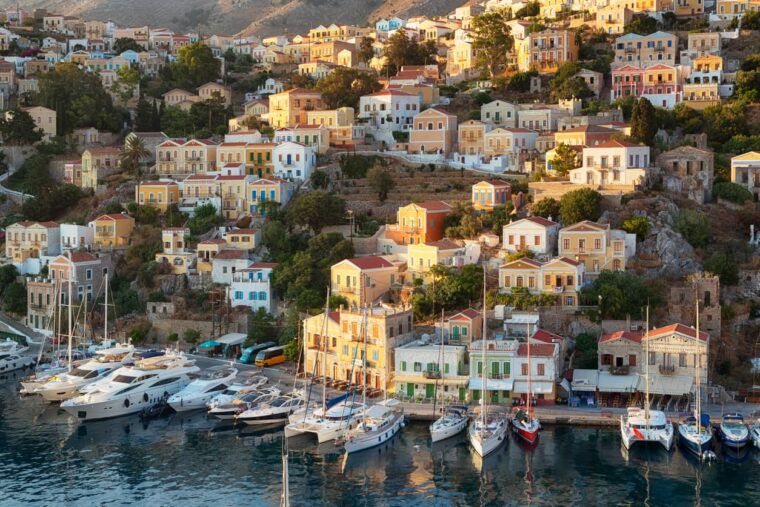The Dodecanese Islands, an enchanting archipelago adrift in the Southeastern Aegean Sea, beckon to adventurers around the world with their diverse landscapes, rich histories, and captivating cultures. As explorers of the open sea, sailors are privileged to experience these islands in a uniquely intimate manner, the wind guiding them through sparkling turquoise waters from one gem to the next.
These islands have a timeless allure, each holding its individual charms and secrets, from the imposing grandeur of the Colossus in Rhodes to the serene spirituality of St. John’s Monastery in Patmos. In between, a panoply of smaller islands offers pristine beaches, traditional architecture, and a taste of the rich and varied Greek cuisine that changes from island to island.
The Dodecanese Islands, characterized by their warm summers and mild winters, present an excellent sailing destination throughout the year. However, chartering a yacht in this part of the Aegean is more than just controlling a yacht; it’s about immersing oneself in the landscapes, meeting the local people, tasting the food, and understanding the history and culture that imbue these islands with their distinct character.
This comprehensive guide will lead you through everything you need to know about sailing in the Dodecanese Islands: from the region’s history and geography, preparing for your journey, navigating your way around the islands, to the etiquette and safety measures that will ensure an enjoyable and memorable sailing experience. Whether you’re an experienced sailor or a novice eager to tackle the Aegean waves, you’re bound to discover something new and exciting in the pages that follow. So, hoist your sails and prepare for a voyage of a lifetime across the Dodecanese.
KEY TAKEAWAYS
- The Dodecanese Islands offer a rich sailing experience, with numerous islands, each possessing unique charms, from historical landmarks to natural beauty, and local cuisine. Sailors can chart various routes through these islands, adjusting their course according to personal interests and weather conditions.
- Sailing in the Dodecanese requires careful preparation, including securing necessary licenses and safety equipment, understanding local sailing conditions, and respecting nautical etiquette. By doing so, sailors can ensure a smooth and enjoyable journey through the Aegean Sea.
- Beyond sailing, the Dodecanese Islands provide ample opportunities for cultural immersion, water activities, and gastronomic adventures. These activities add depth to the sailing experience, allowing visitors to connect with the local life, history, and environment of the islands.
Understanding the Dodecanese
History of the Dodecanese
The Dodecanese Islands, though geographically small, bear a profound historical legacy. The region has been home to some of the oldest civilizations in history, with signs of human habitation dating back to the Neolithic age. The islands flourished in the classical Greek era and later became significant centers of the Byzantine Empire.
Throughout the centuries, the Dodecanese was captured by numerous powers, leaving a mosaic of influences. The Knights of Saint John fortified Rhodes and other islands, leaving behind medieval castles. Ottoman rule then followed, with some islands like Kastellorizo maintaining significant Italian and British architectural influences due to their historical transitions. This diverse past has shaped the islands’ unique character, evident in their architecture, customs, and traditions.
Geographical Overview
The Dodecanese, meaning ‘twelve islands’ (Dodeca nisia) in Greek, is an island group in the southeastern Aegean Sea, off the coast of Asia Minor (Turkey). It comprises 12 larger and 150 smaller islands, each with its unique charms and attractions. As mentioned in the Guide to Sailing in Cyclades Islands, the Cyclades, a group of around 220 islands, are renowned for their iconic Cycladic architecture seen in famous islands like Santorini and Mykonos, and host the ancient archaeological site of Delos, considered the mythological birthplace of Apollo and Artemis.
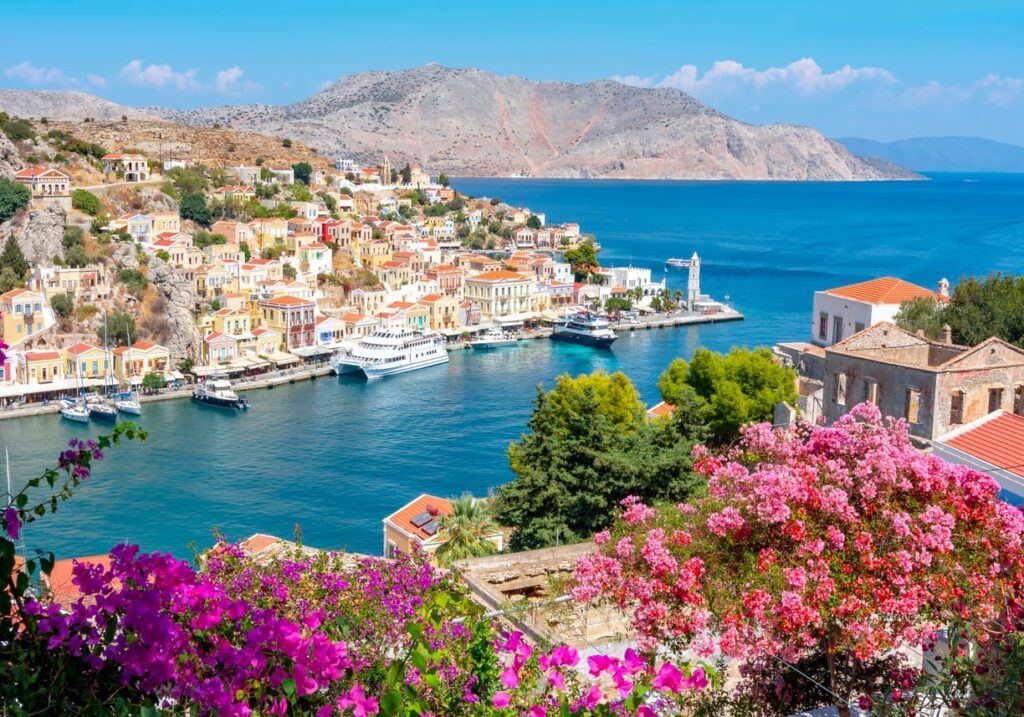
Rhodes, the largest and most cosmopolitan, is famous for its medieval Old Town, a UNESCO World Heritage Site. Kos, one of the popular destinations for yacht charter in Greece, is known for its beautiful beaches and vibrant nightlife. Patmos stands out for its spiritual significance as the location where Saint John wrote the Book of Revelation. Other noteworthy islands include Symi, with its neoclassical houses, and Kalymnos, globally known for sponge diving.
The landscapes range from mountainous terrains, and fertile valleys, to sandy beaches with crystal-clear waters, making each island a unique paradise to explore.
Climate and Sailing Conditions
The Dodecanese enjoys a Mediterranean climate characterized by hot, dry summers and mild, rainy winters. In February, average temperatures can decrease to a cool 12 degrees, while in the peak of summer, they can soar to a sizzling 35 degrees or even higher. The Meltemi winds from the north-northeast peak in July and August, providing exhilarating sailing conditions for experienced sailors.
Spring and autumn are also great times to sail, with fewer crowds, pleasant temperatures, and lighter winds. During these seasons, the islands are adorned with wildflowers in bloom or display the warm hues of autumn, offering stunning landscapes.
The islands’ proximity allows for easy island-hopping, and each harbor offers safe mooring and essential amenities. However, sailors should always be aware of sudden weather changes, especially during the Meltemi season, and keep a close eye on weather forecasts. The sea’s captivating beauty and the charm of the islands make every sailing adventure in the Dodecanese a memorable journey into the heart of the Aegean.
Preparations for Chartering a Yacht
Best Time for Sailing
Choosing the right time to sail the Dodecanese greatly enhances the experience. Summer (June through August) is the peak sailing season, marked by warm temperatures and robust Meltemi winds, making it ideal for experienced sailors seeking an exhilarating journey. However, it’s also the busiest tourist season, with bustling ports and crowded attractions.
Spring (April to early June) and Autumn (September to October) offer a quieter but equally delightful sailing experience. The weather during these periods is milder and more stable, and the winds are more manageable, making it suitable for less seasoned sailors. Additionally, these seasons provide an opportunity to experience the local life and nature, from the spring bloom to the autumn harvest.
Winter sailing (November to March) is possible but recommended only for experienced sailors due to less predictable weather conditions and limited local services as some islands scale down for the off-season.
Necessary Equipment and Supplies
A successful sailing journey depends significantly on the quality and completeness of your onboard equipment and supplies. Key items include safety gear like lifejackets, flares, a first-aid kit, and a liferaft. A VHF radio and GPS system are essential for communication and navigation. Sails should be in excellent condition, and a toolkit should be onboard for any unexpected repairs.
When it comes to supplies, consider both essential and comfort items. Water, food, cooking equipment, and utensils are a must. Also, carry enough fuel for the motor and a spare canister for emergencies. Toiletries, sunblock, insect repellent, towels, bedding, and clothing suited to the season (including waterproof items) should be on your packing list.
Do not forget nautical charts and cruising guides for the Dodecanese, and ensure you have a plan for waste management to leave a minimal environmental footprint. Also, consider entertainment items such as books, games, and snorkeling gear to make your journey more enjoyable.
Licenses and Legal Requirements
Before embarking on your journey, make sure to understand the legal requirements for sailing in Greek waters. First, ensure your boat documents are in order, including registration, insurance, and tax receipts. A valid passport or ID for all crew members is required for identification purposes.
You’ll need an International Certificate of Competence (ICC) or an equivalent national certificate from your home country to sail in Greece legally. The ICC should be accompanied by a VHF Radio Operator’s Certificate. Moreover, Greece requires a Greek Transit Log (GTL), obtained upon arrival in the country and kept onboard throughout your stay.
All foreign-flagged boats must check in and out at a Port Police office when entering or leaving Greek waters. Customs controls can be strict, so ensure you’re compliant with all regulations. For those renting a boat locally, check with your charter company about the paperwork and procedures.
Finally, remember that sailing is subject to international maritime laws, so familiarize yourself with these and adhere to them at all times.
Sailing Routes in the Dodecanese
Rhodes to Kos
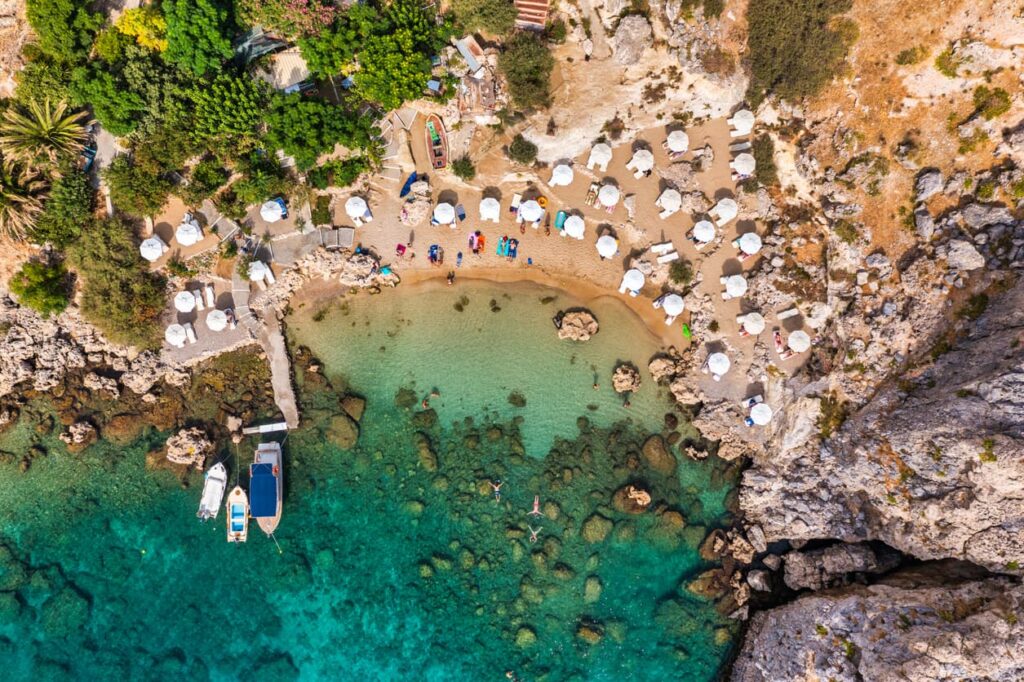
Beginning at the heart of the Dodecanese, Rhodes is an excellent starting point. Spend a day or two exploring the island’s historic sites, including the medieval city, before setting sail. Your first stop could be Symi, a charming island northwest of Rhodes. Symi’s port is a sight to behold, surrounded by pastel-colored neoclassical houses stacked on the hillsides.
After enjoying Symi’s calm and beauty, set your course toward Nisyros. This unique island has an active volcano that you can visit. Its quaint harbor of Mandraki offers a peaceful anchorage, and the traditional Greek village life in Nisyros is a delight to experience.
Next, sail north to Kos, one of the Dodecanese’s major islands. Kos harbors rich history with ancient Greek, Roman, and Ottoman influences. It also offers beautiful beaches and a vibrant nightlife to enjoy.
Spanning roughly 91.9 nautical miles, this route could be traversed in approximately 7 hours and 11 minutes at an average cruising speed of 10 knots, provided there are no stoppages. Bear in mind, these estimates are merely indicative, and it is strongly recommended to meticulously chart your precise route prior to embarking on your yacht charter journey in Greece.
Kos to Patmos
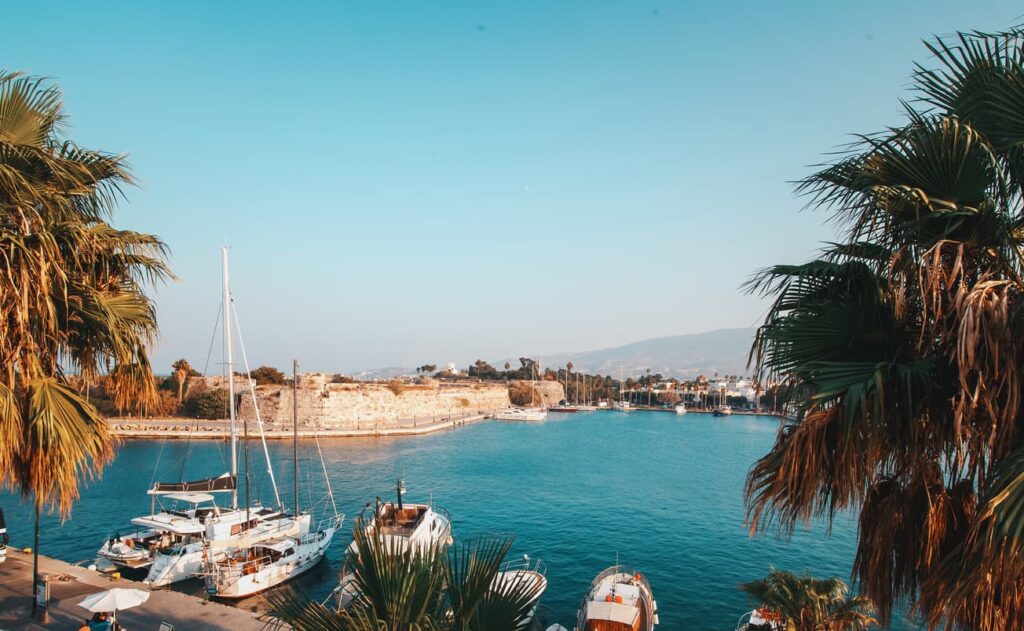
Leaving Kos, set sail for the quiet island of Leros. Leros is known for its Italian-influenced architecture, lovely bays, and the medieval castle of Panagia, offering spectacular views.
From Leros, a short sail to the east brings you to Lipsi, an island complex of 24 islets, with only one inhabited. Lipsi is a quiet place with beautiful sandy beaches, crystal-clear waters, and friendly locals.
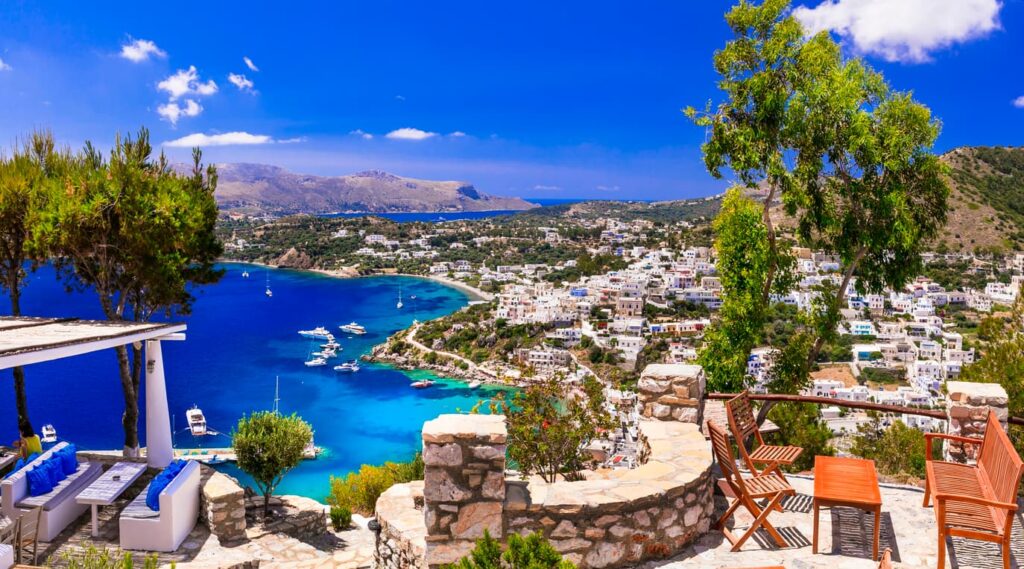
Next, head north to Patmos. Known as the “Island of the Apocalypse,” Patmos is where Saint John wrote the Book of Revelation. Visit the Monastery of Saint John and the Cave of the Apocalypse for a rich historical and spiritual experience.
Encompassing nearly 46.6 nautical miles, this course, given a cruising speed of 10 knots, would approximately require 4 hours and 40 minutes of seamless sailing. These calculations are broadly indicative and it is paramount to meticulously verify your exact route before commencing your yacht charter adventure in Greece.
Patmos to Astypalaia
From Patmos, sail southeast to the remote but charming island of Astypalaia. The journey is long but rewarding. Astypalaia, also known as the “Butterfly of the Aegean,” stands out for its Venetian castle, white-washed houses, and turquoise waters. It’s the westernmost island of the Dodecanese, offering unspoiled landscapes and tranquil beaches.
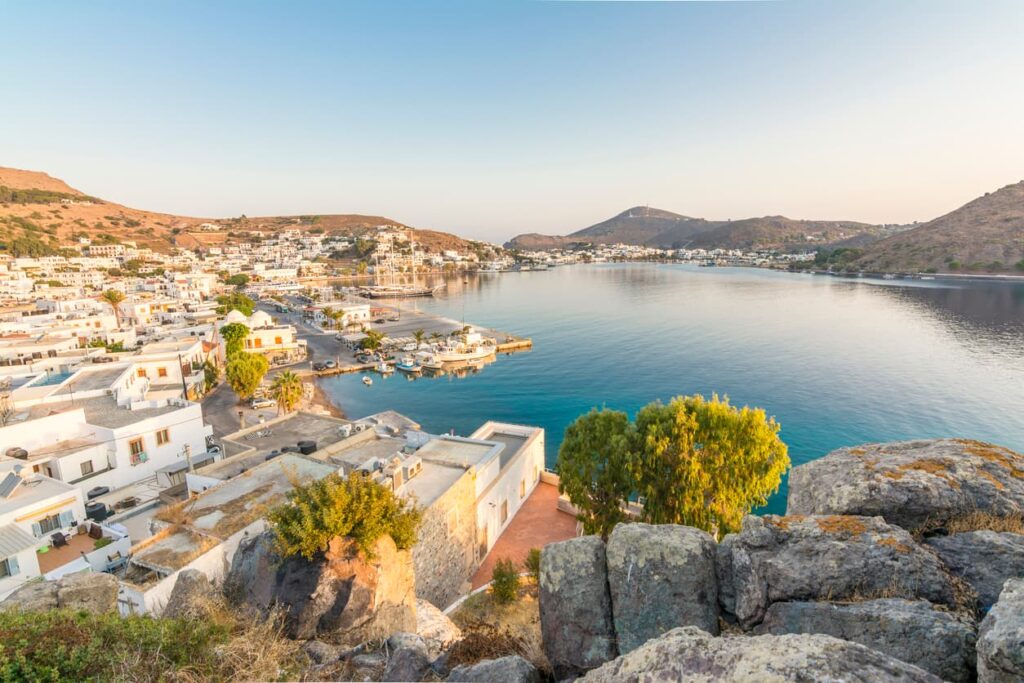
Spanning an estimated 47.2 nautical miles, this route, assuming a cruising speed of 10 knots, would take roughly 4 hours and 43 minutes of uninterrupted sailing. It’s important to note that these figures are generalized estimations, and for a precise and safe yacht charter experience in Greece, it’s highly recommended to thoroughly examine your exact route before setting sail.
Customizing Your Route
These routes for yacht charter in Greece are suggestions, and one of the joys of sailing is the freedom to chart your own path. Each island in the Dodecanese has its unique character and charm, and the distances between islands are relatively small, offering a plethora of options.
Your route can be influenced by many factors, including the length of your trip, weather conditions, and personal interests. Whether you’re keen on exploring historical sites, diving into the local cuisine, or simply enjoying the pristine beaches and clear waters, there’s an island to cater to your desires.
Remember to account for the Meltemi winds when planning your route, especially in the peak summer months. And while it’s good to have a plan, stay flexible and open to changes as you navigate the beauty and wonder of the Dodecanese.
The joy of sailing lies not just in the Dodecanese islands but extends to other beautiful parts of Greece as well. As you continue charting your own paths and exploring the unique character of each island, consider embarking on an adventure across the Ionian Sea. Each island in the Ionian chain offers a unique charm, rich history, and a plethora of experiences waiting to be discovered. Check out our comprehensive Guide to Sailing in the Ionian Islands to broaden your horizons and enrich your sailing experience in Greece.
Nautical Etiquette and Safety
Yacht Charter Etiquette
Yacht charter etiquette in the Dodecanese, like many other places, is a blend of unwritten rules and formal regulations meant to ensure a pleasant experience for all sailors. Observing the following guidelines will help you enjoy a peaceful and respectful sailing journey.
- Communicate: Use your VHF radio responsibly for communication. Keep communications brief, clear, and professional, and avoid unnecessary chatter that can clog up the channels.
- Respect Others: Maintain a safe distance from other vessels, especially when anchoring or mooring. Keep noise levels down, particularly early in the morning and late at night, to avoid disturbing others.
- Environmentally Conscious: Protect the environment by minimizing waste, avoiding throwing garbage overboard, and not disturbing marine life. Respect protected areas and anchoring restrictions.
- Mooring: Always moor your boat responsibly. Respect the mooring arrangements and the rights of others already anchored or moored.
Safety Precautions
Safety at sea is of paramount importance. Adhering to safety guidelines will help ensure that your sailing adventure is enjoyable and free of unnecessary risks.
- Equipment: Ensure that your boat is equipped with the necessary safety equipment, including lifejackets, liferaft, flares, fire extinguishers, and a first-aid kit. Check that all equipment is in good working order before setting sail.
- Check Weather: Always check the weather forecast before you sail. The Aegean Sea can be unpredictable, especially during the Meltemi season, and conditions can change rapidly.
- Communication: Keep your VHF radio on and tuned to the emergency channel (Channel 16). Always let someone know your plans before setting out, including your route and expected return time.
- Navigation: Navigational hazards exist, especially near the shorelines of these rocky islands. Always keep a proper lookout and be aware of your surroundings. Use your navigation charts and GPS to avoid potential hazards.
- Swimming: The Aegean Sea is generally safe for swimming, but be aware of local marine life, strong currents, and boat traffic. Always supervise children near the water.
Remember, safety starts with you. Be responsible, be aware, and you will have a safe and enjoyable sailing experience in the Dodecanese.
Highlights and Activities
Historical Landmarks
The Dodecanese is steeped in history, and exploring its historical landmarks is a must. In Rhodes, wander through the medieval city, a UNESCO World Heritage Site, and visit the Palace of the Grand Master. In Kos, explore the Asklepion, one of the ancient world’s most famous healing temples.
In Patmos, visit the Monastery of Saint John and the Cave of the Apocalypse. Don’t miss the picturesque neoclassical houses in Symi and the fascinating Monastery of Panormitis. In Leros, visit the Castle of Leros, and in Nisyros, explore the ancient walls of the fortress of Paleokastro.
Natural Attractions
The natural beauty of the Dodecanese is a highlight of any sailing adventure. Enjoy the crystal-clear waters and sandy beaches on islands like Kos, Leros, and Lipsi. Visit the active volcano in Nisyros, and enjoy the stunning views from the Venetian Castle in Astypalaia.
Local Cuisine
Indulging in local cuisine is a joy of traveling in the Dodecanese. Each island has its own unique dishes and local products. Taste the Pitaroudia (chickpea fritters) in Rhodes, the cheese-stuffed pastries known as Pouggia in Kos, and the locally made honey in Kalymnos. Sample the delicious local wines, and don’t forget to try the ouzo, a traditional Greek aperitif.
Water Activities
With its crystal-clear waters, the Dodecanese is a paradise for water activities. Snorkeling and scuba diving are popular, with plenty of sites teeming with marine life. The shipwreck in Kalymnos and the reefs around Leros and Patmos are excellent dive spots.
Wind and kite surfing are popular in the summer months, especially in Rhodes and Kos, known for their winds. For a more relaxed experience, paddleboarding, kayaking, and fishing are also great ways to enjoy the Aegean Sea.
When it comes to a yacht charter in Greece, you have the freedom to choose!
Consider exploring Tripadvisor to gain additional insights into your intended destinations.
Remember, whatever activity you choose, always respect local regulations and the environment, and ensure safety at all times.
Check Greece Yacht Charter options.
Conclusion
The Dodecanese Islands offer a wealth of experiences for sailors. From the cultural richness of Rhodes and Kos to the tranquility of Lipsi and Astypalaia, there is a world to explore in this southeastern corner of the Aegean Sea. Each island is a treasure trove of history, natural beauty, and delicious cuisine, set against the backdrop of sparkling turquoise waters.
Whether you’re charting a course through the bustling summer season or seeking the quieter rhythms of spring or autumn, sailing the Dodecanese is a journey of discovery. Respect for the sea, the environment, and the local communities goes hand in hand with the adventure, offering a unique way to delve into the heart of Greek island life.
So prepare your sailing gear, map your route, and let the winds guide you through the timeless allure of the Dodecanese. There is no better way to experience these enchanting islands than from the deck of a sailboat, under the wide open Greek sky.
FAQs
The Dodecanese Islands provide numerous appealing yacht charter routes for sailors. A favorite itinerary begins in Rhodes, proceeding to Symi, then to Nisyros, and finally to Kos. Another popular route starts from Kos, moves to Leros, then Lipsi, and ends at Patmos. Alternatively, you can start from Patmos and make your way to the picturesque Astypalaia. Remember, the beauty of sailing is the freedom to chart your own course, and with the numerous islands in the Dodecanese, you have countless routes to explore.
The best time to sail in the Dodecanese largely depends on your personal preference and sailing skills. Summer (June to August) is the peak sailing season with warm temperatures and robust Meltemi winds, suitable for experienced sailors. However, it is also the busiest tourist season. Spring (April to early June) and Autumn (September to October) offer milder weather, more manageable winds, and fewer tourists, making it a quieter but equally rewarding sailing experience. Winter sailing (November to March) is less popular due to unpredictable weather conditions and reduced local services.
To sail legally in Greece, including the Dodecanese Islands, you need an International Certificate of Competence (ICC) or an equivalent national certificate from your home country. This should be accompanied by a VHF Radio Operator’s Certificate. Additionally, Greece requires a Greek Transit Log (GTL) for all boats sailing in Greek waters. Remember to also carry your boat documents including registration, insurance, and tax receipts, and a valid passport or ID for all crew members.
Safety is paramount when sailing. Ensure your boat is equipped with necessary safety gear, including lifejackets, liferaft, flares, fire extinguishers, and a first-aid kit. Always check the weather forecast before setting sail and keep your VHF radio tuned to the emergency channel. Navigate carefully to avoid hazards, especially near shorelines. If you plan to swim, be aware of local marine life, strong currents, and boat traffic. Lastly, always let someone know your sailing plans, including your route and expected return time.
The Dodecanese Islands offer a wealth of unique cultural experiences. You can explore historical sites like the medieval city of Rhodes, the Monastery of Saint John in Patmos, or the ancient Asklepion in Kos. Experience local cuisine, each island boasting its own traditional dishes and local products. Enjoy local festivals, where you can witness traditional music and dance. Each island in the Dodecanese has its own unique cultural offerings, making it an exciting cultural journey.

